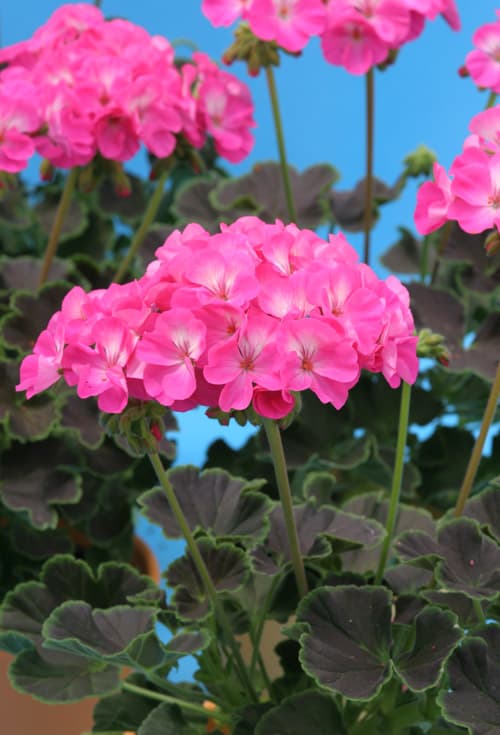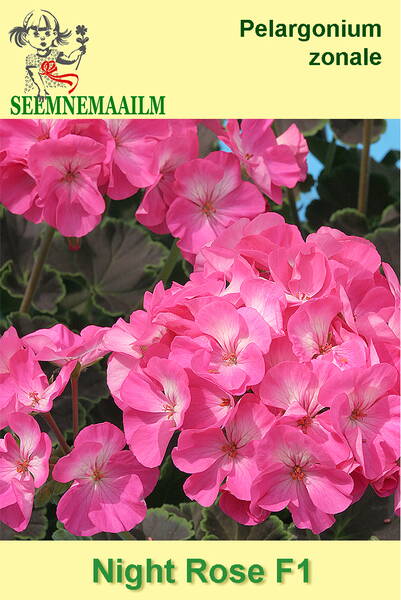Night Rose - a series of zoned pelargoniums is unique due to its decorative brown leaves with a thin green border around the edge. The flowers are purple-pink in color, form large, spherical inflorescences. Plant height: 35 cm. Bush width: 25 cm. Easily tolerates a lack of moisture. With careful care, it can bloom all year round. The plant is placed on sunny east and west windows; in the summer months, it is a wonderful decoration for the yard and flower beds.
1 gram contains 135-200 seeds.
Pelargonium seeds remain viable for 2-3 years (with each year of storage, they age and lose their germination energy).


Eng.: Horseshoe pelargonium. Sven.: Zonalpelargon. Suom.: Pelargoni, pelakuu.
* Unfortunately, these plants are very painful when moving from the street to a room with dry air and poor lighting. Their leaves turn yellow, starting from the bottom, and then dry up, flowering practically stops.
Flowering can continue only at a temperature not lower than +15°C and good lighting, night temperature should not fall below +10°C. Such conditions are possible on glazed loggias or insulated balconies. On cloudy days, plants must be illuminated with fluorescent lamps - 80 watts per 1 m2 for 12 hours. At the same time, watering and fertilizing are slightly reduced.
If there are no such conditions, then the plants are kept on the windowsills. They are pruned a little, dry and yellowed leaves are constantly stripped. Watering is reduced, and top dressing is completely stopped. Plants are fenced off from the dry air of city apartments with a film barrier. They are kept in this state until mid-January. When the natural day begins to lengthen, the plants are heavily pruned. At the same time, all weak, thin shoots are removed, thick ones are cut at a height of 10–15 cm. Watering is intensified and top dressing is applied with complete mineral fertilizer for indoor flowers every 10 days. The plants will have young, strong shoots that can be cut into cuttings in February.
Cuttings with a heel are best rooted - a piece of an old stem. The cuttings should have 2-3 nodes with well-developed leaves and one or two internodes 7 to 15 cm long. The lower leaves are removed, and the growing points are pinched. The cuttings are cut with a new razor and the lower cut is lowered into jars filled with settled water by 8–10 cm. The jars are also placed on window sills, shading them only from the direct sun. There is no need to change the water in the jars, just add it as it evaporates. If some cuttings rot, they are thrown away, the jars are thoroughly washed and fresh water is poured.
First, the cuttings have a growth - callus, and after 3-4 weeks - a good lobe of roots. After that, the plants are planted in pots with a diameter of 10 cm, filled with a substrate of humus, weathered, limed peat or compost and sand in a ratio of 2:2:1. 50 g of complex mineral fertilizer is added to a bucket of the mixture. Mother plants can bloom beautifully in pots for several years, but at the end of winter or in spring, you need to remove the top 1–2 cm of old soil from the pots and add fresh fertile soil.
Zonal pelargoniums can also be grown from seeds. But in this case, they will bloom in about 6 months. Seeds (1 g contains 150-200 pieces) are sown in the usual way, shoots appear after 2 weeks. The grown seedlings dive first into small cups, and then again into the same pots as the cuttings, and into the same substrate.
Cuttings and seedlings are grown with constant watering and fertilizing, and also illuminated on cloudy days. They are planted in open ground at the end of spring frosts, and they are first accustomed to direct sunlight for two weeks, otherwise severe burns are inevitable.











